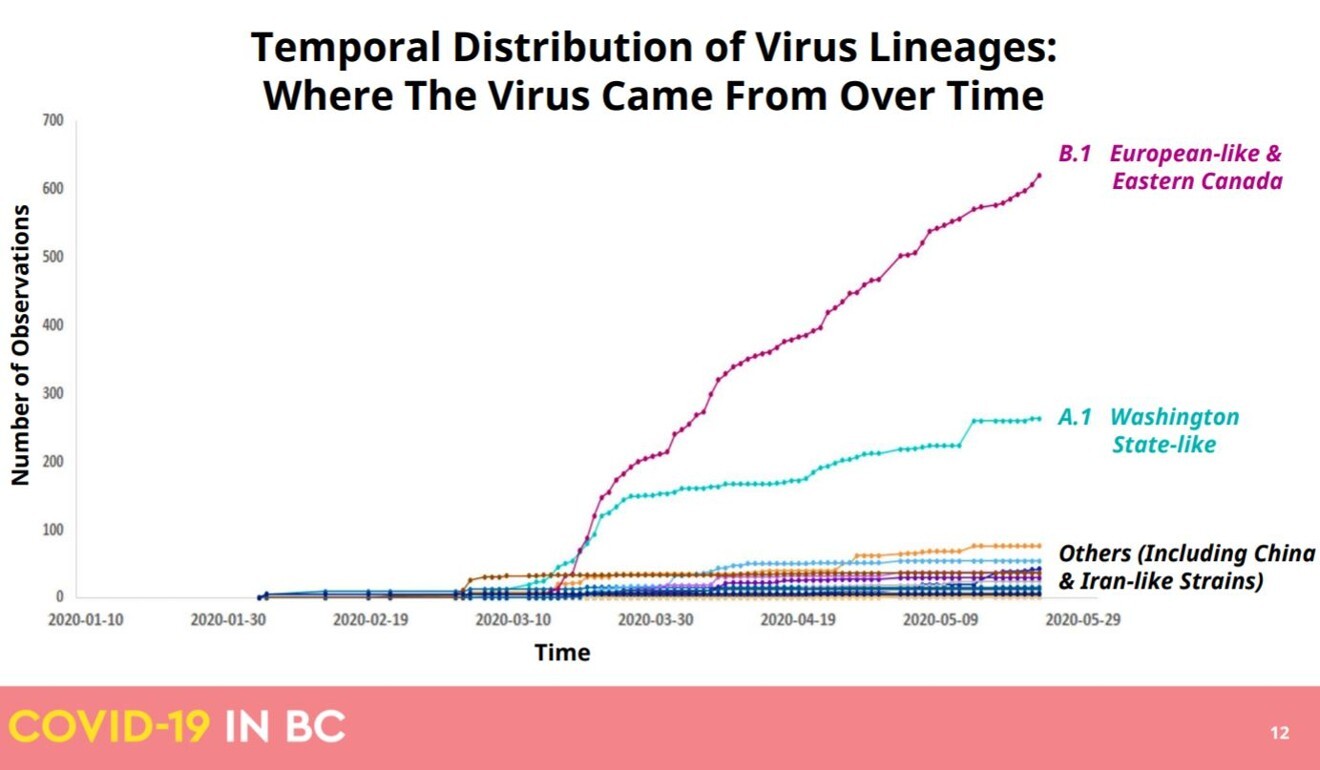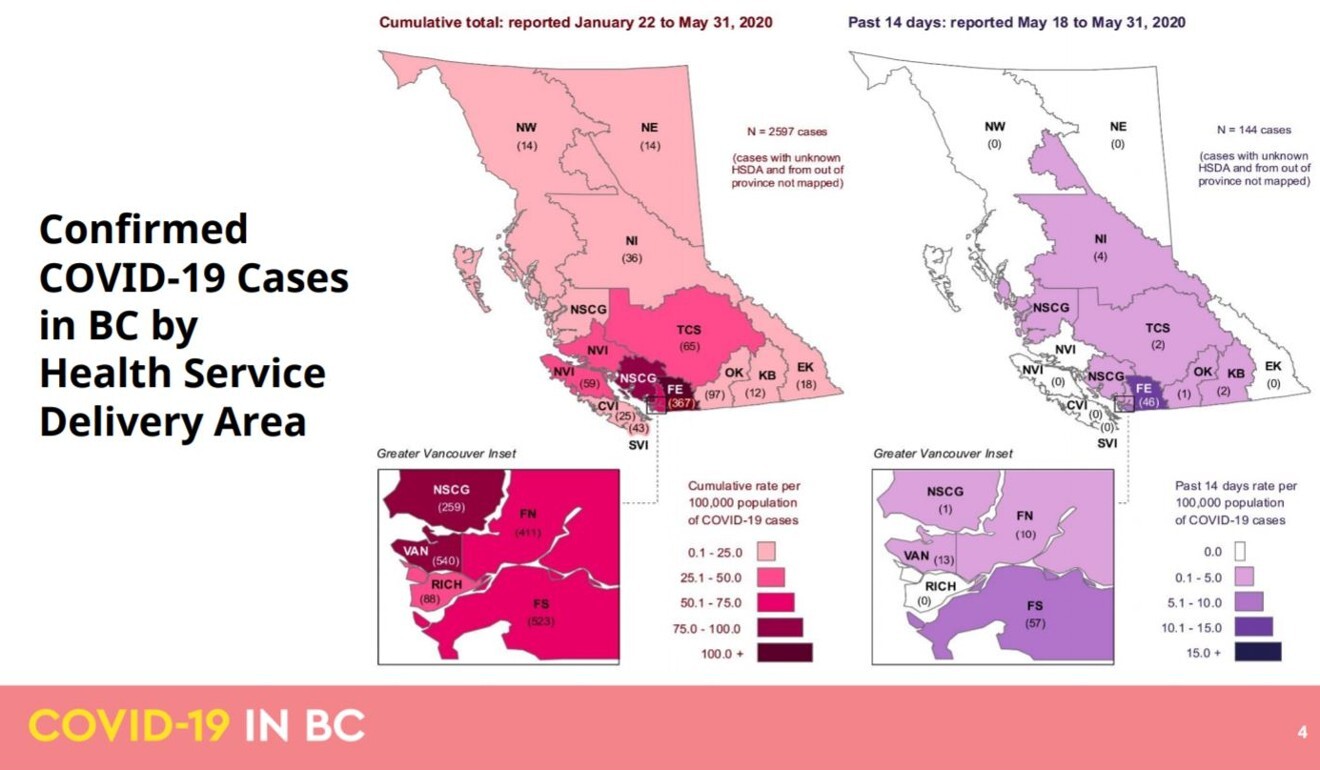
An anti-Chinese virus was spreading in Vancouver. But data that could have broken infection chains of racism was kept secret
- Covid-19 data showing Chinese-dominated Richmond is Vancouver’s least infected area could have undermined racist sentiment – but it was suppressed for months
- Gene sequencing also shows BC’s pandemic mostly involves virus strains that arrived from the US, eastern Canada and Europe, while Chinese strains fizzled
On Thursday, more than four months into British Columbia’s Covid-19 pandemic, officials finally released regionalised data showing that Chinese-majority Richmond – once feared as potential ground zero for the outbreak – was in fact metro Vancouver’s least infected area.
Ironically, the goal of withholding the data for so long was to avoid stigmatising certain communities.
That may not have worked out so well.
I say “ironically” because, in the meantime, incidents of anti-Asian and anti-Chinese racism associated with Covid-19 were spreading.
A frail 92-year-old was hurled out of a store by a burly man shouting anti-Chinese slurs about Covid-19. A young woman in a face mask was punched in the face on the street. The stone lions standing guard in Chinatown were repeatedly defaced with Covid-19 graffiti.
Vancouver’s Deputy Chief Constable Howard Chow said the increase in hate crimes was “staggering”, with 29 anti-Asian cases being investigated this year, as of May 22, compared with four in the same period last year.
To all of that we can add the background noise on social media and newspaper comment threads. Covid-19 was being conflated with Asianness, with Chineseness, in Vancouver. Instead of being lauded for behaviours that may have helped stave off the worst of the pandemic – extensive mask wearing, early social distancing and voluntary self-isolation – the region’s Chinese communities were bearing the brunt of an ignorant backlash, premised on Covid-19 being somehow their fault.
All this while, unacknowledged and unbeknown to most folk in metro Vancouver, the most Chinese city in the world outside Asia was quietly proving the stereotypes wrong.

Thursday’s data release showed that Richmond (a 54 per cent ethnically Chinese municipality, population about 200,000) has the lowest Covid-19 infection rate in the greater Vancouver region. Richmond’s cumulative rate of 44 infections per 100,000 people (as of May 31) compares to 83 per 100,000 in the neighbouring city of Vancouver.
A couple months ago, provincial health officer Dr Bonnie Henry had justified the withholding of regionalised Covid-19 statistics for two reasons: to avoid stigmatising residents of heavily infected areas and to prevent complacency among places with low infection rates.
“With this disease, as with many communicable diseases, there is still very much a stigma associated with it,” she said on March 31. It was, she said, “not a non-disclosure policy” but a tactic designed to support those people who were infected.
She emphasised the goal of achieving compliance with anti-pandemic measures across the entire province – regardless of disparities in regional infection rates.
Asian Canadian women abused, punched, spat on. Is it racist maskaphobia?
But evidence of Richmond’s low infection rate leaked out. In late April, a local health official let slip in a Facebook live event that Richmond only accounted for about 10 per cent of cases in the Vancouver Coast Health region at the time, compared with 60 per cent in Vancouver. That allowed the South China Morning Post to correctly estimate that Richmond’s infection rate was only about half that of Vancouver’s, and about one-third the national rate at the time.

Also in Thursday’s data dump: genomic sequencing data from 700 to 800 virus samples showing that China was not the immediate source of the vast majority of infections chains that arrived in BC.
It’s not clear how long BC’s Centre for Disease Control had the broad thrust of this information at hand – but could earlier release have also helped tamp down the embers of anti-Chinese sentiment? It couldn’t have hurt.
Although scientists broadly agree that Covid-19 spread around the world after originating in China in late 2019, subsequent mutations created various strains around the world, allowing the BC CDC to determine the more recent origin of the province’s infections.
Suspect in racist incident on Vancouver bus is dead, police say
The first cases to arrive in BC in January did indeed involve strains of Covid-19 from Wuhan – “not surprisingly”, said Henry. But these quickly fizzled out. Those infection chains were swiftly broken.
Instead, strains that arrived in BC from Europe, eastern Canada and Washington state have dominated the pandemic here, being linked to wide community spread and deadly outbreaks in long-term care homes.
Dozens of cases were linked to a person who attended a dental conference in Vancouver and had recently been in Germany. But there were several people at the conference who were ill, and they were subsequently linked to 87 infections. There were three strains, all European.

Then came a large cluster linked to Washington state, which shares a border with BC, where more than 1,100 people have died of Covid-19. “What was happening in Washington state very much affected our pandemic here in BC,” said Henry.
In contrast, early infections imported from China did not result in exponential transmission because people were self-isolating as soon as they got ill and because of successful contact tracing, said Henry.
“We were working with the [Chinese community], and the community themselves in BC took this very seriously. We supported people and we talked about it in January and February, about community activities, to support people coming from China to self-isolate,” Henry said on Thursday.
It was only on March 10 that there was rapid growth of infections involving the Washington state strains, seeding outbreaks in the BC community and in long-term care homes. European strains similarly took off fast around the same time, notably via the dental conference.
“There was a time that people didn’t realise the risk that came from other countries [than China],” said Henry. It became “much more challenging to find people” [via contact tracing] once the Washington strain took hold, she said.
As early as January, the Chinese community in Richmond was already avoiding crowded places. This was self-motivated social distancing. The community did not need to be told by local authorities what to do – they observed what was happening in China, Hong Kong and elsewhere, so they did the same. They stayed home. They masked up. In doing so they may have helped spare the rest of BC from a far worse pandemic.
Now, cases of Covid-19 in Richmond are rare. It has not recorded a new case since at least May 18 and is alone among the regions of greater Vancouver to have this distinction.
To suggest the disease originated in China last year is nothing controversial, and scientifically sound. To equate the pandemic and its spread in BC with Chineseness, to blame BC’s Chinese communities for its spread, has been shown to be flat-out wrong.

It would be unreasonable to blame health authorities for the various anti-Asian violence meted out during the pandemic. I doubt such perpetrators pay much attention to genomic sequencing and infection statistics. And Dr Bonnie Henry’s empathy has been a beacon for British Columbians during the pandemic.
But would it have helped mitigate the spread of anti-Chinese sneers and hatred in BC if Richmond’s infection statistics, and perhaps the genomic sequencing, had been released earlier?
Some of those infection chains of bigotry could have been broken earlier.
At the very least, the data now proves the woeful wrongness of those infected by the anti-Chinese virus. They are our true covidiots.
The Hongcouver blog is devoted to the hybrid culture of its namesake cities: Hong Kong and Vancouver. All story ideas and comments are welcome. Connect with me by email [email protected] or on Twitter, @ianjamesyoung70.

